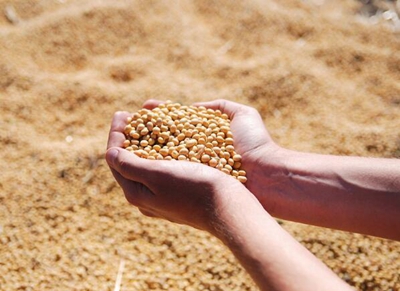Do 2017 kinds of soybeans make money? forecast of soybean price trend
In 2016, the Ministry of Agriculture promoted the agricultural supply-side structural reform, focusing on adjusting and optimizing the planting structure, requiring the northeast of China's major grain producing areas to appropriately reduce the planting area of corn and switch to soybeans. So what is the market situation of soybeans? What will be the price trend of soybeans in 2017? can you make money growing soybeans? With these questions, let's take a look at the specific analysis.

2017 Forecast of soybean price trend
1. The price of domestic soybeans rose.
The supply of goods in Northeast China, Inner Mongolia and other places has bottomed out, there is not much surplus grain in Heilongjiang, continuous rainfall and poor transportation in the producing areas along the Huaihe River, the commodity inspection of imported soybeans continues to be strict, and the entry into the food field has significantly decreased. The auction of stored soybeans has been constantly postponed, aggravating the market supply tension, and the soybean market still shows a bullish atmosphere. In June, domestic soybean prices rose. The average purchase price of domestic soybeans in Heilongjiang was 1.75 yuan per jin, up 3.6 percent from the previous month, down 0.7 percent from the same period last year. The entry price of domestic soybeans in Shandong was 2.19 yuan per catty, up 3.5 percent from the previous month and down 1.6 percent from the same period last year. The main soybean contract on the Dalian Futures Exchange (September 2016) closed at 1.92 yuan per jin, up 5.6% from the previous month and down 9.9% from the same period last year. The ex-factory price of medium soybean meal in Shandong was 3281 yuan per ton, up 16.7% from the previous month and 27.7% from the same period last year.
two。 International soybean prices have risen sharply.
South American soybeans were hit by flooding during the harvest season, resulting in lower-than-expected yields. The Buenos Aires Grain Exchange in Argentina predicted that Argentina's soybean production would be 56 million tons, 7.9% less than the previous year. The USDA supply and demand report estimates that the carry-over stocks of new and old soybeans in the United States are 260 million cattails and 370 million cattails respectively, both lower than the average market forecast. The market expects hot and dry weather in the Midwest soybean belt in July, and soybean growth will be restricted. At the end of June, the United States Department of Agriculture released a report on the acreage of American beans, which reached 83.688 million acres, an increase of 1% over the previous year, and the market was empty. In addition, the weakening US dollar and the continued strength of crude oil prices are also beneficial to the soybean market. International soybean prices rose sharply in June. The average price of the main soybean contract on the Chicago Board of Trade (CBOT) was $422.79 per ton, up 8.9% from the previous month and 21.5% from the same period last year.
3. The price gap between imported soybeans and domestic soybeans narrowed compared with last month.
In June, the after-tax price of imported soybeans rose sharply, the price of domestic soybeans in sales areas rose, and the price gap between domestic and foreign soybeans narrowed compared with the previous month. The price of imported soybeans in Shandong is 1.78 yuan per jin after landing tax, which is 0.42 yuan lower than that of local domestic soybeans, and the price difference is 0.1 yuan lower than that of last month. The FOB price of soybeans in the Gulf of Mexico of the United States is 1.44 yuan per jin, which is 0.75 yuan lower than the purchase price of domestic soybeans in Shandong, and the price difference is 0.08 yuan lower than that of last month.
Soybean imports rose 14.5% from 4.1 to May compared with the same period last year.
According to customs statistics, China imported 7.6642 million tons of soybeans in May, up 8.4% from the previous month, 25.1% from the same period last year, 2.958 billion US dollars, 10.9% from the previous month and 11.8% from the same period last year. Exports of 14100 tons of soybeans, down 2.4% from the previous month and 25.5% from the same period last year, exports were 12.1438 million US dollars, 18.7% from the previous month and 33.0% from the same period last year. The export of soybean meal was 165400 tons, an increase of 30.7 percent over the previous month and a decrease of 10.4 percent over the same period last year. From January to May, imports of soybeans totaled 30.9975 million tons, up 14.5 percent from the same period last year, with imports of US $12.37 billion, down 4.5 percent from the same period last year; exports of soybeans were 58700 tons, down 14.56 percent from the same period last year, and exports were 52.5984 million US dollars, down 24.6 percent from the same period last year. The main sources of soybean imports from January to May were the United States (50.6% of total imports) and Brazil (45.1%).
5. Global soybean stocks are expected to decline in 2016.
In June, the USDA estimated global soybean production of 324 million tons in 2016, an increase of 10.44 million tons over the previous year. Among the major producing countries, the United States is expected to produce 103 million tons of soybeans, down 3.3 percent from the previous year; Brazil produced 103 million tons of soybeans, an increase of 6.2 percent over the previous year; and Agentin produced 57 million tons, an increase of 0.9 percent over the previous year. Global soybean consumption is expected to be 328 million tons in 2016 and 17, an increase of 3.1 per cent over the previous year. The global soybean stock at the end of the period is 66.31 million tons, with a stock-to-consumption ratio of 20.2%, down 2.5% from the previous year and the lowest in nearly five years.
6. Local dynamics.
According to a survey conducted by the large Business Institute in June, the soybean area in Heilongjiang is expected to increase by no more than 25%, but the traditional main producing areas such as Nenjiang and Heihe have been replanted obviously, and the replanted area of soybeans is about 45%. According to the statistics of Jilin Committee of Agriculture, the sown area of soybeans in the province is 3.23 million mu, an increase of 28% over the same period last year. According to the survey of autumn crop planting intention of the local economic and social investigation team of Henan Province, the soybean planting area of Henan Province has soared by 123.4% this year.
Do 2017 soybeans make money?
1. Growing soybeans will be the trend of the times.
Last year, China consumed 93 million tons of soybeans, while its domestic output was only more than 10 million tons. Last year, it imported 81.69 million tons of soybeans and 8.8179 million tons of soybean oil. No matter from the perspective of national policy or market demand, the future development of soybean planting will be the trend of the times.
Before 2014, the soybean acreage in Northeast China accounted for more than 80% of the country's soybean area. After the soybean acreage declined for six consecutive years, the role of pure price factors or planting benefit factors began to weaken, while the role of technical factors gradually strengthened. such as crop rotation, planting habits, labor and drying restrictions of competitive crops, management risks of over-planting corn and other factors are conducive to maintaining and further expanding the soybean area.
two。 Planting positioning focuses on the high end.
At present, most of the domestic soybeans are food beans, and the number of oilbeans is relatively small, so if we can increase the price of food beans, it is tantamount to helping domestic soybeans to find a good way to increase production and income. For example, the purchase price of sprouts grown in Hailun area of Heilongjiang Province is not only 0.4 yuan / kg higher than that of ordinary soybeans, but also the sales channel is more smooth; some farms and agricultural cooperatives have blazed an incomparably bright path by developing the market for small packaged soybeans such as organic and green.
- Prev

The price of traditional Chinese medicine has risen sharply. Experts predict that the traditional Chinese medicine industry may usher in a new rise in the next three years.
The price of traditional Chinese medicine has risen sharply. Experts predict that the traditional Chinese medicine industry may usher in a new rise in the next three years.
- Next

The price of white-feathered broiler chickens has soared 10-fold. Experts predict that the high price will continue until at least 2017.
The price of white-feathered broiler chickens has soared 10-fold. Experts predict that the high price will continue until at least 2017.
Related
- A course of planting techniques and methods on how to grow carrots
- How to plant the latest tulips?
- Is it better to pick tea in the morning or in the afternoon? When is the best time for tea to be picked? what is the third or fifth tea?
- Launch Yuanxiao Happy combination Haocha + Tea Yuan healthy Taste
- Penghu Tourism "Fireworks 20 Parade with You"
- 2022 West Lake Happiness holds "Digital Revitalization Voucher" and draws iphone13 and laptop.
- Banqiao Fuzhou social houses are designed to change start-up combined with police elimination to create a safe and livable environment
- The convenient measure of "mechanical weeding" in Xinbei has been abused and the Agriculture Bureau has imposed heavy penalties on the illegal land consolidation.
- Changgeng University Joins Hands with Four Memory Factories to Rescue Memory Talent Shortage
- The list of Taiwan's top 100 MVP managers is listed by the Director-General of the Farmers' Association of Sanxia District.

